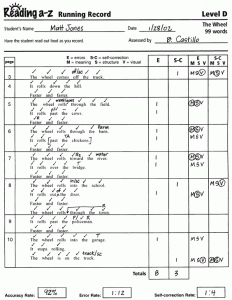Running Records
The style of running records varies by a school or district’s chosen program, but the main function is the same. A running record is conducted on a one-on-one basis, with the teacher or aid asking the student to read a passage. The conductor takes notes on the student’s proficiency, marking for misreading, self-correcting, and other accuracy.
Grade: Primary, could be intermediate especially for diagnostic assessment.
For, of, as: for
Summative or Formative? Formative.
Strengths:
This is a non-subjective way to collect data.
The one-on-one style assessment creates notes to review later.
Students may feel more comfortable reading to one person rather than out loud in class. This creates a more accurate representation of skill.
Weaknesses:
Running records must be done in isolation, therefore extra help is needed in the classroom.
The activity might feel like a test, and make some students nervous, which would alter the results.
The subject of the reading may be boring, or out of context for the learner. Reading is easier when one is familiar with the subject matter.
Source:
https://www.readinga-z.com/newfiles/levels/runrecord/runrec.html
https://www.readinga-z.com/helpful-tools/about-running-records/
Sample:

